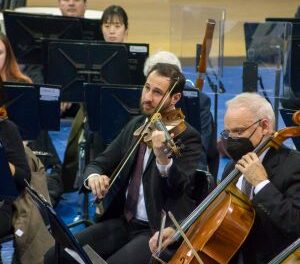Only good things can result when a concert program features at least one principal musician from the North Carolina Symphony – Chamber Music Raleigh‘s sold-out program at the NC Museum of Art was no exception. Featuring not only NCS concertmaster Brian Reagin but also principal cellist Bonnie Thron, joined by splendid pianist Solomon Eichner, the program explored the evolution of the piano trio form from Haydn to Beethoven to Brahms, spanning from 1795 to 1882. Many interesting contrasts were made, including the roles of the instruments themselves, since the fortepiano instrument was still developing over this time. Regardless of the musical differences, though, the trio of musicians played with technical ease and convincing expression for each style, whether it was the sprightly Haydn, dramatic Beethoven, or passionate Brahms.
Haydn’s Piano Trio in G, Hob. XV: 25 is nicknamed “Gypsy” for the Hungarian-styled finale, which differs from the much smoother previous movements with its tempo changes and fiery melody. Articulation was lovely here, with the three instruments matching perfectly. Eichner’s delicate melodic sixteenth notes in one of the first movement’s variations was a preview of the intricacy to come later in the program. In the middle Poco adagio, Reagin and Thron balanced the weight of simple yet gorgeous phrasing, hinting at the expressive tug-of-war of the Brahms.
As could be expected of Beethoven, his Piano Trio in D, Op. 70, No. 1 is stormy and emotionally flighty. However, the cloudy and muted middle movement, given away by the work’s nickname “Ghost,” may surprise some. Compared to the piano’s presence in the Haydn before it, here the range of the piano expands. Eichner often played two different roles – melodic material in the high treble range while his left hand constituted percussion. In the haunting Largo, Thron and Reagin’s flexuous harmonies together were like careful breaths, but with rigid dynamic control. All this tension was released in the breezy Presto.
Although the first movement of Brahms’ second Piano Trio in C, Op. 87 could hardly be described as “breezy,” given the composer’s complex nature, Eichner, Reagin, and Thron made the Allegro moderato’s changing metrical emphasis sound organic and flowing. The second movement saw pain, with violinist and cellist leaning in to exchange this emotion and pianist rocking beneath with his beautiful but mournful melody. The rhythmic transformations of the fourth movement’s motif close out the trio, swirling and insistent.
Just in case we didn’t hear enough of this trio’s beautiful phrasing and expression, the three musicians played Hugo/Fritz Kreisler’s arrangement of “Londonderry Air,” also known as “Danny Boy.” Technically, this trio, published in 1922, expanded this program’s reach another forty years! The melody, though simple, was traded gorgeously from violin to cello to piano with fluency, and dissolved any lingering melodic tension from the earlier music.












